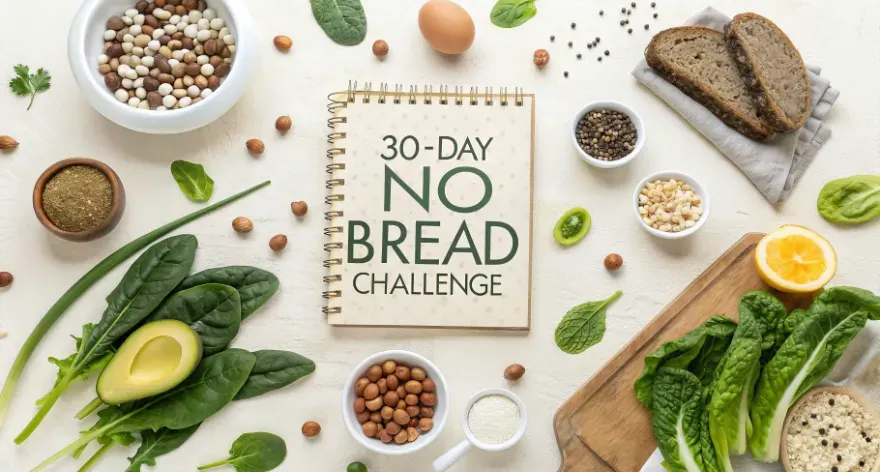What Happens When You Stop Eating Bread for 30 Days?

Pulling bread off your plate for 30 days sounds simple—until you realize how deeply it’s woven into most meals. Toast at breakfast. Sandwiches at lunch. Pasta and dinner rolls. Cutting it out can spark real change—and for many, the results are noticeable well before the month is up.
But what actually happens in your body and brain when you cut the carbs? From digestive shifts to energy fluctuations, understanding how your system reacts to a month without bread can help you make smarter long-term decisions—not just about bread, but about your overall approach to food.
Why Bread Is So Controversial in Modern Diets
Bread sits at the crossroads of comfort, culture, and controversy. While traditional breads made from whole grains can offer fiber, B vitamins, and minerals, the modern standard is often ultra-processed, made with refined flours, added sugars, and preservatives.
Refined bread spikes blood sugar rapidly, then leaves you hungry a couple of hours later. It can contribute to insulin resistance, bloating, and inflammation for some people—especially those with gluten sensitivity or metabolic issues. That said, not all bread is the enemy. Context matters, and how your body responds is a big part of the picture.
Your Body in Week 1: Cravings, Energy Shifts, and Water Weight
The first week off bread often feels like breaking up with an old friend. Your body—accustomed to quick carbs—starts craving that rapid energy source. Mood swings, irritability, and even mild headaches can kick in, especially if your diet was previously high in refined starches.
You might also notice an initial drop on the scale. That’s water weight. Carbohydrates are stored in the muscles and liver as glycogen, and each gram of glycogen binds to about 3–4 grams of water. Cut the carbs, and you drop the water—quickly. It’s not fat loss yet, but it’s a noticeable change.
Week 2 and 3: Digestion, Inflammation, and Mental Clarity
By week two, the cravings often subside, and many people report smoother digestion. Less bloating. Fewer energy crashes. If you were reacting to gluten or additives in bread, you might notice clearer skin or less joint discomfort—signs of reduced inflammation.
Some even describe a shift in mental clarity. With blood sugar more stable, there are fewer brain fog episodes or mid-afternoon slumps. The gut also begins to recalibrate, especially if you're replacing bread with fiber-rich veggies, legumes, and whole foods. This stage can feel like a turning point.
By Week 4: Weight, Blood Sugar, and Long-Term Adaptation
After 30 days, the body tends to settle into a rhythm. Weight loss may become more noticeable—not just from water loss but from reduced overall calorie intake and better insulin sensitivity. Bread can be incredibly calorie-dense for its satiety level, so cutting it often trims daily intake without even trying.
Blood sugar control often improves, especially in those with prediabetes or insulin resistance. You might find your energy more stable throughout the day and recovery from workouts more efficient. However, if bread was your main source of fiber or B vitamins, a nutrient gap might start to show—fatigue, irregular digestion, or even cravings for starchy foods.
Whole Grain vs Refined Bread: Not All Loaves Are Equal
It’s crucial to make a distinction here—refined bread and whole grain bread are not the same thing. Whole grain breads contain fiber, protein, and micronutrients that support digestion, cardiovascular health, and blood sugar control. Refined white bread? Mostly just starch and additives.
If the bread you gave up was white or ultra-processed, you’re likely seeing major benefits. But if it was sprouted grain or minimally processed whole wheat bread, the effects might be more subtle—and in some cases, the fiber or nutrient loss could outweigh the benefit. The key is in the quality, not just the category.
Smart Replacements to Avoid Nutrient Gaps
Cutting bread shouldn’t mean cutting whole food groups. Many people unintentionally lower their fiber intake when they drop bread—leading to constipation or a disrupted microbiome. To stay balanced, swap in high-fiber carbs like:
- Quinoa, oats, sweet potatoes
- Legumes: lentils, chickpeas, black beans
- Veggies like broccoli, Brussels sprouts, and carrots
- Chia seeds, flax, and psyllium husk for fiber and gut health
Also, ensure you’re still getting complex carbs for brain function and energy, especially if you're active. This keeps your metabolism humming and your workouts strong.
Should You Stay Off Bread for Good?
That depends. Some people thrive without bread—they feel leaner, more energized, and less bloated. For others, bread in moderation—especially the whole grain kind—fits into a healthy, sustainable diet. The 30-day experiment gives you data: how your body reacts, what you miss, and what you don't.
If you're gluten-sensitive or dealing with metabolic issues, avoiding bread might be a long-term strategy. But if you’re simply looking to clean up your eating, switching to better-quality bread and being mindful of portions might be enough. Sustainability matters more than temporary restriction.
Final Thoughts: 30 Days Without Bread—What It Really Reveals
Giving up bread for a month isn't about punishment—it’s a chance to reset and observe. You learn how much you relied on bread for convenience, comfort, or filler. You discover whether it’s helping or hindering your health. And you realize how much better food can taste when it’s built around nutrients, not white flour.
The real value isn’t in demonizing bread—it’s in building awareness around what you eat and why. Whether you stay off bread or bring it back in with intention, the next 30 days might just reshape more than your plate. They could reshape your entire approach to food.
References:
National Library of Medicine – Glycogen and water loss: https://www.ncbi.nlm.nih.gov/books/NBK499830/
PubMed – Effects of low-carb diets on weight and metabolic health: https://pubmed.ncbi.nlm.nih.gov/23651522/
Mayo Clinic – Fiber-rich alternatives: https://www.mayoclinic.org/healthy-lifestyle/nutrition-and-healthy-eating/in-depth/high-fiber-foods/art-20050948
